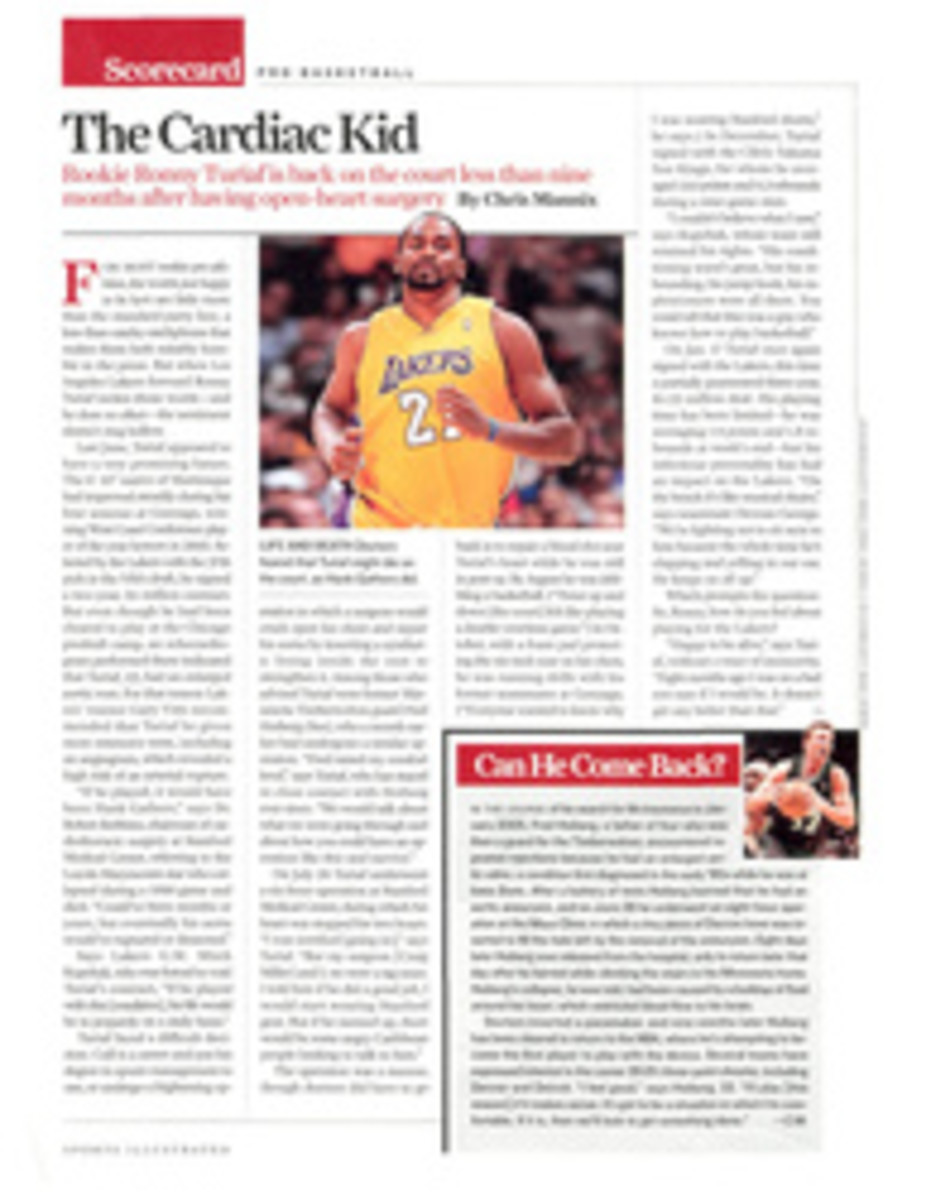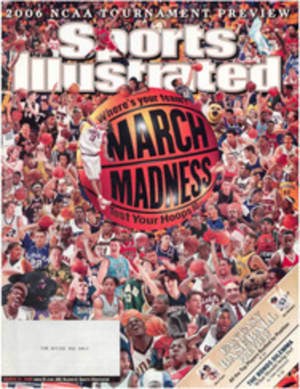
The Cardiac Kid
For most rookiepro athletes, the words just happy to be here are little more than the standardparty line, a less-than-catchy catchphrase that makes them look suitably humblein the press. But when Los Angeles Lakers forward Ronny Turiaf recites thosewords--and he does so often--the sentiment doesn't ring hollow.
Last June, Turiafappeared to have a very promising future. The 6'10" native of Martiniquehad improved steadily during his four seasons at Gonzaga, winning West CoastConference player of the year honors in 2005. Selected by the Lakers with the37th pick in the NBA draft, he signed a two-year, $1 million contract. But eventhough he had been cleared to play at the Chicago predraft camp, anechocardiogram performed there indicated that Turiaf, 23, had an enlargedaortic root. For that reason Lakers' trainer Gary Vitti recommended that Turiafbe given more extensive tests, including an angiogram, which revealed a highrisk of an arterial rupture.
"If heplayed, it would have been Hank Gathers," says Dr. Robert Robbins, chairmanof cardiothoracic surgery at Stanford Medical Center, referring to the LoyolaMarymount star who collapsed during a 1990 game and died. "Could've beenmonths or years, but eventually his aorta would've ruptured ordissected."
Says Lakers G.M.Mitch Kupchak, who was forced to void Turiaf's contract, "If he played withthis [condition], his life would be in jeopardy on a daily basis."
Turiaf faced adifficult decision: Call it a career and put his degree in sports management touse, or undergo a frightening operation in which a surgeon would crack open hischest and repair his aorta by inserting a synthetic lining inside the root tostrengthen it. Among those who advised Turiaf were former MinnesotaTimberwolves guard Fred Hoiberg (box), who a month earlier had undergone asimilar operation. "Fred raised my comfort level," says Turiaf, who hasstayed in close contact with Hoiberg ever since. "We would talk about whatwe were going through and about how you could have an operation like this andsurvive."
On July 26 Turiafunderwent a six-hour operation at Stanford Medical Center, during which hisheart was stopped for two hours. "I was terrified [going in]," saysTuriaf. "But my surgeon [Craig Miller] and I, we were a tag team. I toldhim if he did a good job, I would start wearing Stanford gear. But if he messedup, there would be some angry Caribbean people looking to talk to him."
The operation wasa success, though doctors did have to go back in to repair a blood clot nearTuriaf's heart while he was still in post-op. By August he was dribbling abasketball. ("Twice up and down [the court] felt like playing adouble-overtime game.") In October, with a foam pad protecting the six-inchscar on his chest, he was running drills with his former teammates at Gonzaga.("Everyone wanted to know why I was wearing Stanford shorts," he says.)In December, Turiaf signed with the CBA's Yakama Sun Kings, for whom heaveraged 13.0 points and 6.3 rebounds during a nine-game stint.
"I couldn'tbelieve what I saw," says Kupchak, whose team still retained his rights."His conditioning wasn't great, but his rebounding, his jump hook, hisexplosiveness were all there. You could tell that this was a guy who knows howto play basketball."
On Jan. 17 Turiafonce again signed with the Lakers, this time a partially guaranteed three-year,$1.23 million deal. His playing time has been limited--he was averaging 1.9points and 1.8 rebounds at week's end--but his infectious personality has hadan impact on the Lakers. "On the bench it's like musical chairs," saysteammate Devean George. "We're fighting not to sit next to him because thewhole time he's clapping and yelling in our ear. He keeps us all up."
Which prompts thequestion: So, Ronny, how do you feel about playing for the Lakers?
"Happy to bealive," says Turiaf, without a trace of insincerity. "Eight months agoI was on a bed not sure if I would be. It doesn't get any better thanthat."
Can He Come Back?
IN THE COURSE of his search for life insurance inJanuary 2005, Fred Hoiberg, a father of four who was then a guard for theTimberwolves, encountered repeated rejections because he had an enlarged aorticvalve, a condition first diagnosed in the early '90s while he was at IowaState. After a battery of tests Hoiberg learned that he had an aortic aneurysm,and on June 28 he underwent an eight-hour operation at the Mayo Clinic in whicha tiny piece of Dacron hose was inserted to fill the hole left by the removalof the aneurysm. Eight days later Hoiberg was released from the hospital, onlyto return later that day after he fainted while climbing the stairs in hisMinnesota home. Hoiberg's collapse, he was told, had been caused by a buildupof fluid around his heart, which restricted blood flow to his brain.
Doctors inserted a pacemaker, and nine months laterHoiberg has been cleared to return to the NBA, where he's attempting to becomethe first player to play with the device. Several teams have expressed interestin the career 39.6% three-point shooter, including Denver and Detroit. "Ifeel good," says Hoiberg, 33. "I'll play [this season] if it makessense. It's got to be a situation in which I'm comfortable. If it is, thenwe'll look to get something done."
PHOTO
LISA BLUMENFELD/GETTY IMAGES (TURIAF)
LIFE AND DEATH Doctors feared that Turiaf might die on the court, as Hank Gathers did.
PHOTO
NATHANIEL S. BUTLER/NBAE/GETTY IMAGES (HOIBERG)

